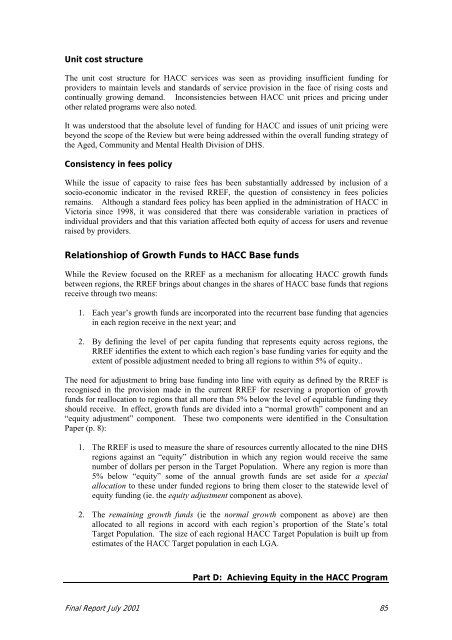Final Report on RREF 2001 - Department of Health
Final Report on RREF 2001 - Department of Health
Final Report on RREF 2001 - Department of Health
You also want an ePaper? Increase the reach of your titles
YUMPU automatically turns print PDFs into web optimized ePapers that Google loves.
Unit cost structure<br />
The unit cost structure for HACC services was seen as providing insufficient funding for<br />
providers to maintain levels and standards <strong>of</strong> service provisi<strong>on</strong> in the face <strong>of</strong> rising costs and<br />
c<strong>on</strong>tinually growing demand. Inc<strong>on</strong>sistencies between HACC unit prices and pricing under<br />
other related programs were also noted.<br />
It was understood that the absolute level <strong>of</strong> funding for HACC and issues <strong>of</strong> unit pricing were<br />
bey<strong>on</strong>d the scope <strong>of</strong> the Review but were being addressed within the overall funding strategy <strong>of</strong><br />
the Aged, Community and Mental <strong>Health</strong> Divisi<strong>on</strong> <strong>of</strong> DHS.<br />
C<strong>on</strong>sistency in fees policy<br />
While the issue <strong>of</strong> capacity to raise fees has been substantially addressed by inclusi<strong>on</strong> <strong>of</strong> a<br />
socio-ec<strong>on</strong>omic indicator in the revised <strong>RREF</strong>, the questi<strong>on</strong> <strong>of</strong> c<strong>on</strong>sistency in fees policies<br />
remains. Although a standard fees policy has been applied in the administrati<strong>on</strong> <strong>of</strong> HACC in<br />
Victoria since 1998, it was c<strong>on</strong>sidered that there was c<strong>on</strong>siderable variati<strong>on</strong> in practices <strong>of</strong><br />
individual providers and that this variati<strong>on</strong> affected both equity <strong>of</strong> access for users and revenue<br />
raised by providers.<br />
Relati<strong>on</strong>shiop <strong>of</strong> Growth Funds to HACC Base funds<br />
While the Review focused <strong>on</strong> the <strong>RREF</strong> as a mechanism for allocating HACC growth funds<br />
between regi<strong>on</strong>s, the <strong>RREF</strong> brings about changes in the shares <strong>of</strong> HACC base funds that regi<strong>on</strong>s<br />
receive through two means:<br />
1. Each year’s growth funds are incorporated into the recurrent base funding that agencies<br />
in each regi<strong>on</strong> receive in the next year; and<br />
2. By defining the level <strong>of</strong> per capita funding that represents equity across regi<strong>on</strong>s, the<br />
<strong>RREF</strong> identifies the extent to which each regi<strong>on</strong>’s base funding varies for equity and the<br />
extent <strong>of</strong> possible adjustment needed to bring all regi<strong>on</strong>s to within 5% <strong>of</strong> equity..<br />
The need for adjustment to bring base funding into line with equity as defined by the <strong>RREF</strong> is<br />
recognised in the provisi<strong>on</strong> made in the current <strong>RREF</strong> for reserving a proporti<strong>on</strong> <strong>of</strong> growth<br />
funds for reallocati<strong>on</strong> to regi<strong>on</strong>s that all more than 5% below the level <strong>of</strong> equitable funding they<br />
should receive. In effect, growth funds are divided into a “normal growth” comp<strong>on</strong>ent and an<br />
“equity adjustment” comp<strong>on</strong>ent. These two comp<strong>on</strong>ents were identified in the C<strong>on</strong>sultati<strong>on</strong><br />
Paper (p. 8):<br />
1. The <strong>RREF</strong> is used to measure the share <strong>of</strong> resources currently allocated to the nine DHS<br />
regi<strong>on</strong>s against an “equity” distributi<strong>on</strong> in which any regi<strong>on</strong> would receive the same<br />
number <strong>of</strong> dollars per pers<strong>on</strong> in the Target Populati<strong>on</strong>. Where any regi<strong>on</strong> is more than<br />
5% below “equity” some <strong>of</strong> the annual growth funds are set aside for a special<br />
allocati<strong>on</strong> to these under funded regi<strong>on</strong>s to bring them closer to the statewide level <strong>of</strong><br />
equity funding (ie. the equity adjustment comp<strong>on</strong>ent as above).<br />
2. The remaining growth funds (ie the normal growth comp<strong>on</strong>ent as above) are then<br />
allocated to all regi<strong>on</strong>s in accord with each regi<strong>on</strong>’s proporti<strong>on</strong> <strong>of</strong> the State’s total<br />
Target Populati<strong>on</strong>. The size <strong>of</strong> each regi<strong>on</strong>al HACC Target Populati<strong>on</strong> is built up from<br />
estimates <strong>of</strong> the HACC Target populati<strong>on</strong> in each LGA.<br />
Part D: Achieving Equity in the HACC Program<br />
<str<strong>on</strong>g>Final</str<strong>on</strong>g> <str<strong>on</strong>g>Report</str<strong>on</strong>g> July <strong>2001</strong> 85
















